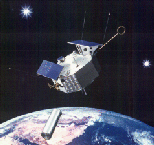

US Air Force's Combined Release and Radiation Effects Satellite

Mission Briefing :
CRRES was a joint NASA / DOD undertaking originally built for STS launch. It was subsequently
modified for launch on an Atlas Centaur, and was boosted into orbit on July 25th 1990 3:21 pm EDT.
The spacecraft suffered a critical power subsystem failure in October 1991, having traversed a
substantial fraction of near Earth local time (200K gif of coverage), performing
valuable studies of Earth bound radiation belts up to geostationary orbit.
The mission carried payload instrumentation from the
Mullard Space Science Lab's Space
Plasma Physics Group. This
instrument was the Low Energy Plasma Analyser (LEPA).

Objectives :
Operations supported three major objectives :
- NASA performance of active chemical release experiments in the ionsphere and magnetosphere.
- US DOD studies of the natural radiation environment and studies of the effects of this radiation environment upon microelectronic components as CRRES traveled through inner and outer radiation belts of the earth.

- US DOD low altitude studies of ionspheric irregularities which are performed in the ionsphere near the orbit perigee.

Orbital Data
The spacecraft operated in a highly elliptical geosynchronous transfer orbit (upto 6.6 Re).
35,768 x 350 km, inc 18 deg, period 10.5 hours, decreasing to 9.5 hrs Oct 91.

 The Mullard Space Science Lab's Space Plasmas group flew an experiment
investigating thermal plasma in the eV to 40 keV range, gathering data on
electron and ion distributions in energy, azimuthal, and polar angle -
LEPA.
The Mullard Space Science Lab's Space Plasmas group flew an experiment
investigating thermal plasma in the eV to 40 keV range, gathering data on
electron and ion distributions in energy, azimuthal, and polar angle -
LEPA.

References
Surviving Radiation in Space, Andrew Coates, New Scientist, pg 42,
21st July 1990
Combined Release and Radiation Effects Satellite, A.L.Vampola,
Journal of Spacecraft and Rockets, Vol 29, No. 4, July-August 1992.

 Low Energy Plasma Analyser
Low Energy Plasma Analyser
 SWRI CRRES Page
SWRI CRRES Page
 CRRES/LOMICS data (under SPACERAD)
CRRES/LOMICS data (under SPACERAD)

 Mullard Space Science Lab.
Mullard Space Science Lab.
 Space Plasma Physics Group.
Space Plasma Physics Group.

This page is maintained by :-
Nick Flowers (njf@nojunk-removethis-mssl.ucl.ac.uk), +44 1483 274111
Space Plasma Physics Group, Mullard Space Science Laboratory,
Holmbury St. Mary, Dorking, Surrey, RH5 6NT, United Kingdom

Adapted in part from AFGL documentation.
Version 2.2: Updated March 8th, 1995, 1856 GMT, NJF.
e Ariane-5 explosion and the subsequent damage to the
PEACE instruments.








 The Mullard Space Science Lab's Space Plasmas group flew an experiment
investigating thermal plasma in the eV to 40 keV range, gathering data on
electron and ion distributions in energy, azimuthal, and polar angle -
LEPA.
The Mullard Space Science Lab's Space Plasmas group flew an experiment
investigating thermal plasma in the eV to 40 keV range, gathering data on
electron and ion distributions in energy, azimuthal, and polar angle -
LEPA.

 Low Energy Plasma Analyser
Low Energy Plasma Analyser SWRI CRRES Page
SWRI CRRES Page  CRRES/LOMICS data (under SPACERAD)
CRRES/LOMICS data (under SPACERAD)
 Mullard Space Science Lab.
Mullard Space Science Lab.
 Space Plasma Physics Group.
Space Plasma Physics Group.
